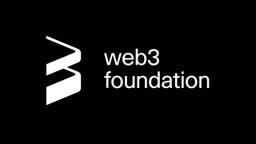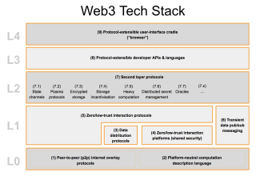Web3 Foundation

Web3 Foundation

Web3 Foundation - The Next Evolution of the Internet - Dr. Gavin Wood
Web3 Foundation (founded in 2017) nurtures and stewards technologies and applications in the fields of decentralized web software protocols, particularly those which utilize modern cryptographic methods to safeguard decentralization to the benefit and for the stability of the Web3 ecosystem.
Polkadot and Kusama are the flagship protocols of Web3 Foundation.
In December 2020, Web3 Foundation announced the launch of Polkadot's Thousand Validators Programme. Applicants could be eligible to receive nominations from Web3 Foundation to help kickstart their Polkadot transaction validating node. By joining the program, users can support the strength of the network by contributing to the shared security of Polkadot and creating more decentralization. [19][21][23]
Overview

Juan Benet, founder and chief executive of Protocol Labs, talks about the Web 3.0 vision and how it relates to humanity going from a pre-computing civilization to a post-computing civilization.
Web3 Foundation was founded by Dr.Gavin Wood in 2017. Dr.Aeron Buchanan, and Reto Trinkler are core team members.
Dr. Gavin Wood is the founder and current director of Parity Technologies Ltd.
He has designed state-of-the-art analysis tools and programming languages, as well as co-founded several technology startups. Dr. Wood has presented to numerous audiences around the world from keynotes at regional technology conferences to musings on the future of legal systems at Harvard. He holds a Ph.D. in Computer Science from the University of York.
Previously, he was the chief technology officer and co-founder of the Ethereum Project. He is the co-designer of the Ethereum Protocol, author of its formal specification, and created and wrote the first functional Ethereum implementation. Dr. Wood designed and stewarded the Solidity language, was the project chief of the IDE, and designed and implemented the Whisper protocol. [8]
Dr. Aeron Buchanan has been involved with the Web 3.0 vision since its inception, joining the Ethereum project as a mathematical modeler in 2014 and going on to be head of European operations and regulatory compliance.
He received his doctorate from the Robotics Department of Oxford University in the field of computer vision after working as an algorithm designer for the special-effects industry. He read engineering and computer science for his undergraduate degree.
Dr. Buchanan designed algorithms for unmanned aerial vehicles, started tech companies building light-show controllers and blockchain technology, and acted as a consultant to economics and ecological research laboratories. He is currently an advisor to several important blockchain projects that aim to make advancements in consensus platform technology and more readily bring their benefits to society and the economy.[8]
Reto Trinkler is the founder of Trinkler Software.
He is also the co-founder of Melonport AG, a blockchain-based platform that enables participants to set up, manage, and invest in technology-regulated digital investment funds.
With a background in mathematics from ETH Zurich, Reto Trinkler has been developing Ethereum smart contracts since the platform’s inception. Prior to that, Trinkler developed a profitable trading algorithm for sports-betting exchanges in C++. [8]
Their passion is delivering Web 3.0, a decentralized and fair internet where users control their own data and identity. Web3 Foundation believes in a decentralized internet where:
Users own their own data, not corporations
Global digital transactions are secure
Online exchanges of information and value are decentralized [3]
Web 3.0 Technology Stack
Layer 0 Overview
Layer 0 is the lowest layer.
It is the foundation upon which the higher layers are built.
For example, the first component of Layer 0 provides the necessary networking capabilities necessary for building peer-to-peer networks.
Layer 0 is made up of two components that can be reused amongst Layer 1 technologies.
These are the standard basic building blocks out of which some layer 1 technologies can be assembled:
- Peer-to-peer (p2p) Internet Overlay Protocols
e.g. Devp2p, Libp2p
2. Platform-neutral computation description language
e.g. VM, WASM, UTXO
Layer 1 Overview
Layer 1 technology provides the functionality of distribution and interaction.
This layer is made up of four components: [7]
- Data distribution protocols
4.Low-trust interaction platforms
e.g. Polkadot
5.Zero/Low-trust interaction protocols
- Transient data messaging
e.g. Whisper, Matrix
Layer 2 Overview
Layer 2 is an enhancement layer for the lower layers of the Web 3 tech stack.
Included in this component are meta-protocols, or layer 2 protocols, that provide enhanced features such as scaling, compute, and encrypted messaging.
This layer is made up of a single component layer: [7]
- Second layer protocols
(7.1) State channels - e.g. Counterfactual, Raiden Network, Lightning Network, FunFair
(7.2) Plasma protocols - e.g. Loom Network, OmiseGO
(7.3) Encrypted Storage - e.g. NUCypher, Parity Secret Store
(7.4) Storage incentivization - e.g. Filecoin, Sia, Storj
(7.5) Heavy computation - e.g. Cartesi, Golem, TrueBit
(7.6) Distributed secret management - e.g. Parity Secret Store
Layer 3 Overview
- Protocol-extensible developer APIs & languages
web3.js - This is the Ethereum compatible JavaScript API which implements the Generic JSON RPC spec. It's available on npm as a node module, for bower and component as an embeddable js, and as a meteor.js package.
ether.js - Complete Ethereum wallet implementation and utilities in JavaScript.
oo7.js - A small library providing what might be termed as reactive expressions, Bonds (hence the name). Classes deriving from Bond are expected to determine when their value has changed and call trigger accordingly.
Solidity - Solidity is a contract-oriented, high-level language for implementing smart contracts. It was influenced by C++, Python, and JavaScript and is designed to target the Ethereum Virtual Machine (EVM). Solidity is statically typed, supports inheritance, libraries, and complex user-defined types among other features.
Rust - Rust is a systems programming language that runs blazingly fast, prevents segfaults, and guarantees thread safety.
Layer 4 Overview
Layer 4 is the top layer of the Web 3 tech stack.
This is the layer at which the user interacts most easily interacts with Web 3 technology.
This layer is made up of one component: [7]
- Protocol-extensible user-interface cradle ("browser")
Status - With Status your mobile device becomes a light client node on the Ethereum Network, enabling you to access Ethereum’s entire ecosystem from anywhere.
MetaMask - MetaMask is a bridge that allows you to visit the distributed web of tomorrow in your browser today. It allows you to run Ethereum DApps right in your browser without running a full Ethereum node. MetaMask includes a secure identity vault, providing a user interface to manage your identities on different sites and sign blockchain transactions.
MyCrypto - MyCrypto is a free, open-source, client-side interface. It allows you to interact directly with the Ethereum blockchain while remaining in full control of your keys & your funds.
MyEtherWallet - MyEtherWallet is a free, open-source, client-side interface. It allows you to interact directly with the Ethereum blockchain while remaining in full control of your keys & your funds.
Parity - Parity comes with an extensive, easy-to-use, in-built Ethereum Wallet and Ðapp environment that can be accessed via your Web browser of choice.
Projects
Web3 Foundation supports Web 3.0 teams and open-source projects through funding, advocacy, research, and collaborations.
Web3 Foundation Registrar
Setting an on-chain identity by using the W3F Registrar provides a good basis for validators to get into and stay in the active validator set and for other token holders to participate in Governance and the Treasury. The service is simple, open-source, and with a fee of only 0.25 DOT (to cover operations), cost-effective. The benefits can be summarized as follows:
Advantages of a verified identity for validators:
Make your validator easily identifiable for nominators and provide a point of contact
Build and maintain your reputation in the ecosystem as a valuable member of the community and bond with your nominators
Attract new nominators and use your reputation to kickstart additional validators
Advantages of a verified identity for all token holders:
Become a public figure in the ecosystem by linking your on-chain account with your off-chain activity and help your on-chain proposals and candidacies
Build your reputation as an active member of the community
Make your on-chain behavior visible to your followers [17]
Polkadot - Web3 Foundation's Flagship Protocol
Polkadot is a scalable sharded chain and the first protocol that provides a secure environment for cross-chain composability.
Kusama: Canary Network
Kusama is a scalable development network built on nearly the same codebase as Polkadot. It’s designed for teams who want to move fast and innovate.
XCMP: Cross-Chain Message Passing
A subset of Polkadot, XCMP is a decentralized messaging protocol that emphasizes privacy and security.
Research at Web3 Foundation
Web3 Foundation Research is conducted in-house and in collaboration with various projects and research groups.
The team is primarily located in Zug, Switzerland.
Their research focuses on a number of areas that are relevant to decentralized systems:
Provable Security, Cryptography, and Privacy
Decentralized Algorithms: Consensus and Optimization
Cryptoeconomics and Game Theory
Networking
Behavioral Economics and Useability [9]
Research Team Members
Alfonso Cevallos
Alistair Stewart
Fatemeh Shirazi
Handan Kılınç Alper
Jeff Burdges
Jonas Gehrlein
Oana Ciobotaru
Samuel Häfner
Sergey Vasilyev
Syed Hosseini
Ximin Luo [10]
Grants
The Web3 Foundation grants program funds, software development, and research in the field of decentralized software protocols. The grant program's aim is to steward the Web 3.0 ecosystem and carefully manage Web3 Foundation resources. Web 3 Foundation provides grants that they believe will return the highest impact on the Web 3.0 ecosystem over the long term. Development projects funded through their grants program are broad in scope and include low-level infrastructure development such as alternative client implementations; ecosystem components such as wallets; and software designed to enable direct use cases such as identity and supply-chain modules. Web3 Foundations has funded over 100 projects in over 20 countries. [12]
Thousand Validators Programme
Web3 Foundation launched the Thousand Validators Programme in February 2020 to support Kusama’s validator growth. From February to December 2020, Kusama increased its validators from 25 at launch to 700 validators. On December 3, 2020, the Web3 Foundation announced the Thousand Validators Programme for Polkadot. [20][24]
Those interested in being a validator can apply and follow the validator setup instructions, and may qualify to receive nominations from the Web3 Foundation to help kickstart their Polkadot transaction validating node.
Along with supporting decentralization in Polkadot, Web3 Foundation is also extending the Kusama Thousand Validators Programme and allowing users to run multiple eligible nodes. [18][19]
Transaction validators are computer nodes or servers that “verify that the information contained in an assigned set of parachain blocks is valid,” the Polkadot team explains. Validators also participate in consensus with other validators through a “hybrid” blockchain consensus protocol that “splits the finality gadget (GRANDPA) from the block production mechanism (BABE). While they’re Incentivized for validating blocks of transactions, validators are “slashed", or fined, if they behave in a dishonest manner. [21]
Anyone can apply to become a candidate for being elected as a validator.
The nominated proof of stake (NPoS) protocol selects the set of active validators regularly based on how much stake is backing the candidates. This stake may come from the candidate, “self-stake”, or backing from nominators.
Requirements for Polkadot Thousand Validators Programme
To be a qualifying candidate for the Thousand Validators Programme, users should have:
experience as a validator in the Kusama Thousand Validators Programme, with a reputation rank of 25 or higher
a verified on-chain identity on Polkadot and Kusama
a minimum of 10,000 DOT
validator nodes connect to a dedicated telemetry server
the commission charged at a maximum of 3%
reward destination must be set to ‘Staked’
completed a one-week monitoring period to ensure stable operations
all nodes upgraded to the latest version within 12 hours of its release if it is labeled "critical" or "high" priority and 24 hours if it is labeled "medium" or "low" priority.
Depending on the volume of applicants, Validators with less than 10,000 DOT self staked will still be considered on a case-by-case basis and will need to make a case for good intentions.
This may include what their contributions to the network are, how long they've been a validator, what kind of validator setup they run, what their approach to security is, what regions they operate in, etc. [19]






